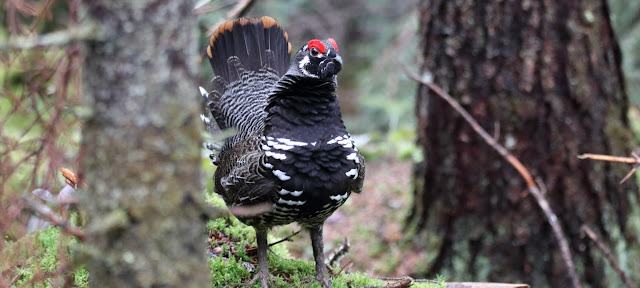Moose Bog Revisited
Wenlock Wildlife Management Area,
northern Vermont
On the 3-5th of May 2017 I birded the spruce-fir
forests of Moose Bog, a place I had visited with Jared Keyes in June 2016. I
re-visited a month earlier this year in order to have a better chance with
Spruce Grouse, one of the elusive boreal species that can be found there.
The drive up from DC took 14 hours (with stops for three
meals). I arrived at my campsite at 9:15 PM in the dark—and finding the
campsite was made more difficult because its address was interpreted by my GPS
as a location about 9 miles north of the place itself.
I camped at Big Rock campground in North Stratford, New
Hampshire. Just across the Connecticut River from Vermont, Big Rock was the
closest open campsite to Moose Bog this early in the season. It was about 9
miles southeast of the birding site. After Memorial Day it is possible to camp
at Brighton State Park in Vermont, about 10 miles west of Moose Bog. Both are
quite satisfactory places to camp.
Moose Bog is situated in the Nulhegan Basin, a big flat
interior lowland surrounded by mountains. On a map, the Basin has the look of
a ancient bolide impact site. This big flat frost pocket is filled with boreal
forest of Black Spruce, Red Spruce, Balsam Fir, Northern White-cedar, White
Birch, and Quaking Aspen. That is its great attraction. The lowest spots are
very boggy, and these boggy areas are attractive to Moose and various north
country birds. Much of the Basin is protected as Silvio Conte National Wildlife
Refuge and two Vermont Wildlife Management Areas (Wenlock and West Mountain).
Much of the Basin has been heavily logged, and there is not much old growth
forest. Some of the very nicest is found along the Moose Bog trail—a flat
walking track about 1.5 miles long on the north side of the bog and not far from route 105.
Early May in northernmost Vermont is the very end of winter.
There was still snow hidden in small patches in the shadier spots, and none of
the deciduous trees had leafed out. The Red Maples were popping their deep red
buds, and the some of the Tamaracks were starting to push out tiny needles. The
hillsides, mainly deciduous, gave off the faintest green haze in patches, where
the trees were being encouraged by the weak sun.
A few Spring Peepers were singing in the bogs, and a few of
the migrant songbirds were starting to arrive on territory: Myrtle Warbler,
Palm Warbler, Northern Waterthrush, Hermit Thrush, the two kinglets.
White-throated Sparrows were in song. Winter Wrens were giving their
roller-coaster vocalization. A pair of Merlins made a lot of noise from some
tall spruces where, I presume, they were putting up a nest.
Also the permanent resident species were in spring mode, in
spite of the winter-like conditions. Black-backed Woodpeckers were drumming, as
were Pileated Woodpeckers.
Moose tracks divotted the dirt roads. The single Moose I
encountered was a sad-looking calf that appeared to be suffering from an
infestation of ticks. The Moose in the area are not doing well, in part because
of ticks.
I was there mainly to track down and photograph the Spruce
Grouse. The males start displaying in late April when the snow is mainly gone.
The males hang out in the interior spruce forest where the ground is covered in
a mat of green moss. Individual males attract females with a display flight and
also a noisy wing flipping. The display flights that I saw were simply quick transits
from the ground up to a nearby branch. This wing sound is what alerted me to
the presence of the single male I encountered on two different days. I never
saw a female in my three days in the woods.
The male I encountered was very tame. He would hang out in a
small patch of woods and move about on the ground and also periodically shift
from the ground up onto low branches.
In both mornings that I encountered him, at around 0745am,
he did not mind my clambering noisily into the thick woods from the trail. Both
times I spent more than a half-hour with the bird, departing and leaving him to
his ongoing activities.
At one point the male, perched on the ground, ran straight
at me and approached to within a couple of feed of me.
I never heard the male make any sounds except those sounds
he produced with his wings. He did not do a lot of display, instead just moving
back and forth from the ground to the low tree branches and back. I assume he
did not confuse me with a female grouse, and that had a female grouse been
present, he would of done his thing more resolutely.
This patch of old growth spruce-fir forest and the adjacent
bog and lake are a wonderful place for a naturalist to spend time. It is very verdant
and peaceful and filled with solitude. The presence (or possible presence) of
all sorts of wilderness creatures makes it all the more enchanting. I saw
Beaver and Muskrat in the wetlands. On my last morning there the main patch was
filled with the footprints of a cow and calf Moose that had passed through
since I had been there late the previous afternoon. I also saw scat of a Black
Bear. I am assuming the Fisher and Porcupine were in the vicinity. The Vermont Fish & Game folks have added a new boardwalk out to the lake itself--which is a wonderful place to take it all in.
One suggestion for future visitors. For those eager to
encounter a Spruce Grouse, be sure to visit early in the year—before the 5th
of May.












No comments:
Post a Comment